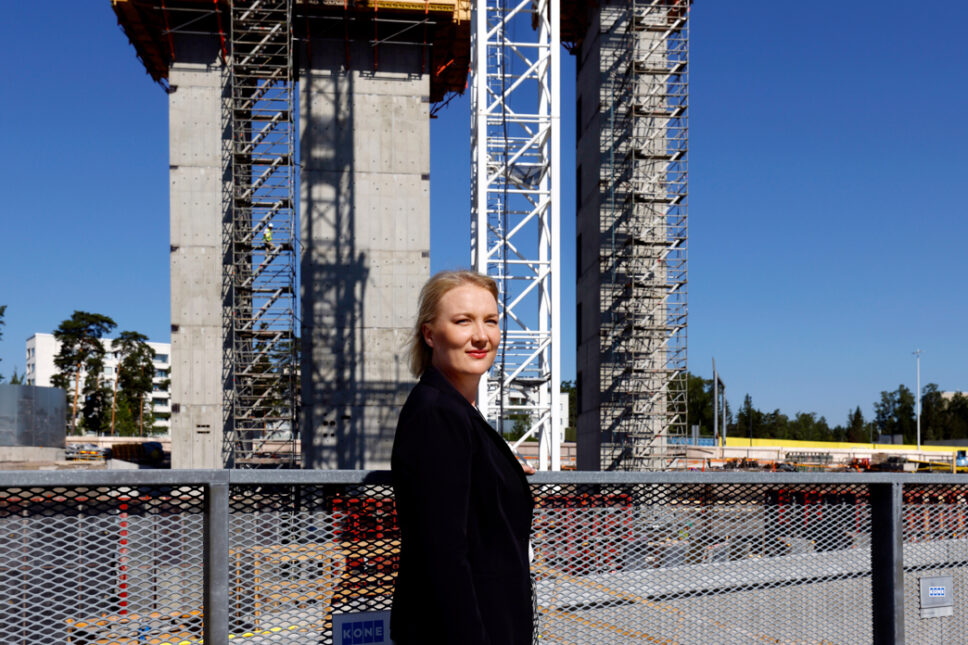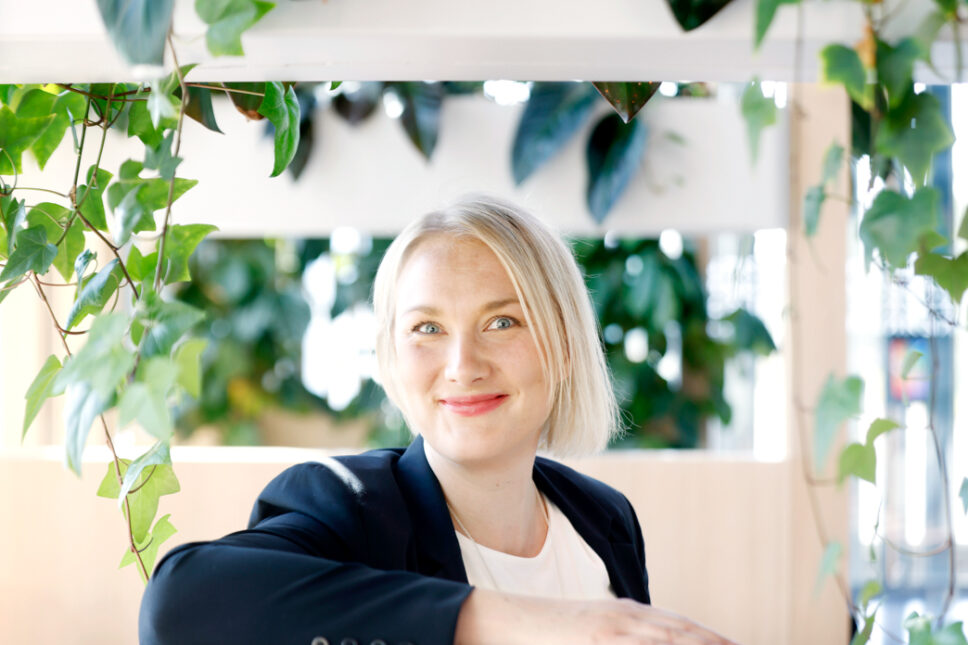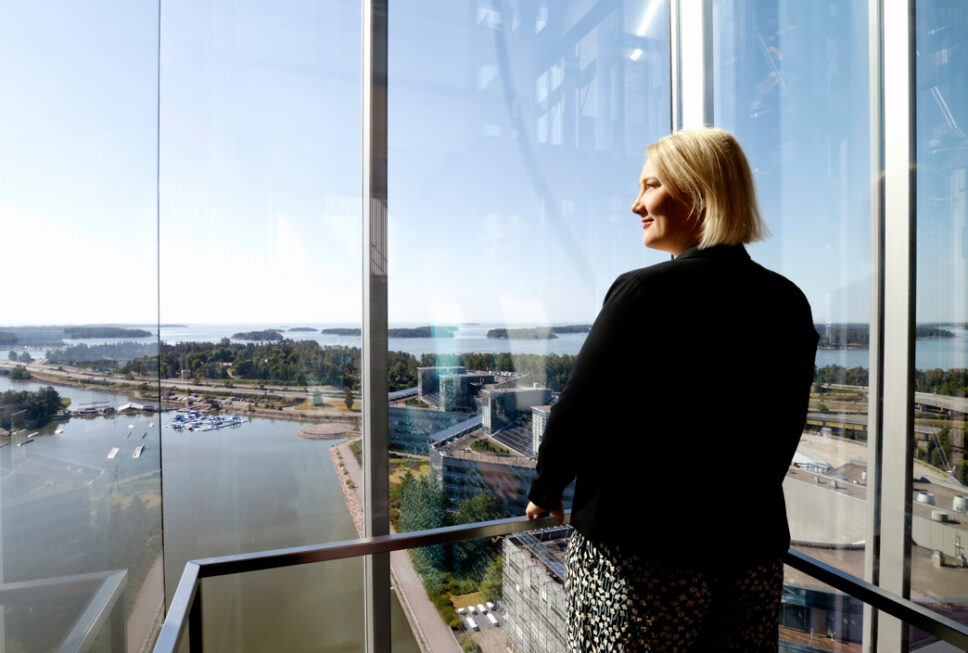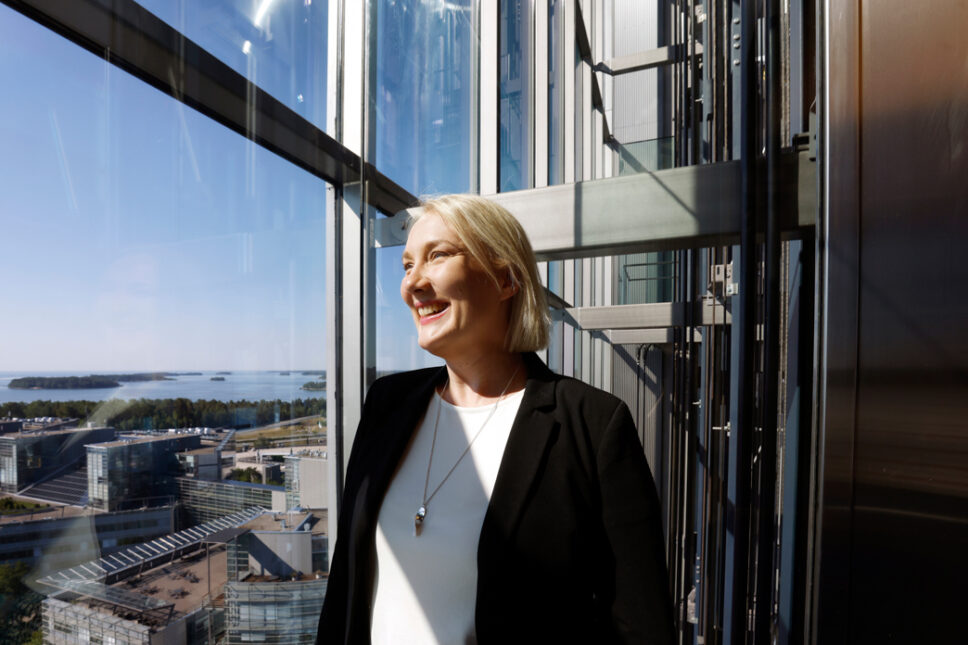KONE created an entirely new business with more than 200 partners in a leading companies project

KONE will soon conclude a leading companies project for Business Finland. The project created an entirely new business for the company in the smart construction sector. The ecosystem has had more than 200 partners and 18 future projects to promote efficient mobility with low emissions. “Creating a network promotes competitiveness and concentrates important expertise in Finland,” says Merja Honkanen, the project manager.
KONE’s activities are all about people flow—moving people safely and efficiently. In 2020, the company launched a leading company project with Business Finland’s support with a broader scope than the widely known lifts, escalators and smart doors.
“Our mission in the leading company project is to develop solutions to support sustainable and smooth urban mobility that address the challenges arising from urbanisation and climate change. A further goal was to resolve how an urban environment can be built in a smart and sustainable way that serves future needs for the next billion people,” says Merja Honkanen, Project Manager of the Flow of Urban Life ecosystem project at KONE.
- The winning projects in Business Finland’s leading company competition will be awarded funding for ambitious research, development, and innovation projects. The funding is intended primarily for joint projects between SMEs, as well as joint projects between companies, research organisations, and universities.
- Competition proposals were required to provide solutions to major future challenges and significantly contribute to the targets of 4% research, development, and innovation (RDI) and 75% employment set out in the Government’s programme.
- Business Finland awards up to EUR 20 million in funding for leading companies and up to EUR 50 million in funding for ecosystems assembled by leading companies. The company or ecosystem must fund the rest.
- The funding is only paid once the targets agreed for the project have been achieved.
- The winning companies have committed to increasing their cumulative RDI investments in Finland by nearly EUR 1.5 billion. If they succeed, the projects will lead to several billion euros of further industrial investments in Finland.
- KONE has various projects under its leading company project. More than 200 partners have participated actively in joint development in the ecosystem projects under the leading company project. Eighteen ecosystem projects are currently in progress, and partial funding has been obtained from Business Finland or the Research Council of Finland. The company has run more than 40 internal product development projects.
More than a billion people use KONE’s equipment daily. By 2030, a billion more people will move to cities that are unprepared for this volume and the problems it will entail. New solutions are required to enable smooth, low-emission mobility.
KONE’s products and equipment have traditionally been inside buildings. During the Business Finland project, KONE and its leading company partners identified opportunities beyond the lift shaft.
“We can optimise and run lifts more efficiently, but we would like to study how people’s mobility will change overall in the future. The number of people is increasing, and climate change is accelerating. This requires entirely new and smart solutions for construction, public transport, car transport, and freight,” says Honkanen.
KONE is not alone in facing these future challenges: the issues of sustainable urban development are being addressed by a wide range of companies of various sizes, research institutes and universities. The project has spawned a corporate foresight network. “Several large companies are scanning different industries and thinking about how climate change, crises, conflicts, energy, construction, and housing will change. The fact that this network has arisen on a national scale in Finland will promote competitiveness and concentrate essential expertise in Finland.”
Breaking new ground in the field of smart construction
The four development areas in KONE’s ecosystem project are sustainable development innovations, smart construction, smart buildings and cities, and smart and sustainable field services.
More than 200 partners have participated actively in joint development within the ecosystem projects under KONE’s leading company project. There are now 18 ecosystem projects that have received partial funding from Business Finland or the Research Council of Finland. The company has run more than 40 internal product development projects.
KONE has a long tradition of product development focusing on smart maintenance and smart buildings, but the leading company project has spurred the company to break new ground in the field of smart construction.

KONE’s ecosystem also involves several partnership projects focusing on digital construction solutions and, for example, using autonomous robots and tools on construction sites.
“We realised that KONE could offer new solutions. They emerged from our collaboration with customers when we identified their pain points. These often include the safety of construction sites, emission impacts, and missed deadlines, which lead to delays in getting buildings into use.”
Honkanen points to the towers on a construction site in Keilaniemi, Espoo. Those buildings will soon be fitted with working lifts, even though the building is far from complete.
“When we have the lifts installed very early, we can use the building’s own lifts during construction, which makes site operations more efficient and the construction process quicker. SRV’s towers in Kalasatama were a pilot site for us. The time saving has been substantial,” Honkanen says.
One day of delay in constructing a tall building can cost hundreds of thousands of euros. One day on a construction site in central London could cost many times more than that. “The lift is the heart of the construction site. It pumps people and goods to the right place at the right time. If logistics stops when the lift stops, the construction site also stops. We identified the potential for efficient lift control to enhance the efficiency of worksite operations in collaboration with our customers,” says Honkanen.
One innovation, major impact
The KONE SiteFlow service has been developed to enable the everyday monitoring and management of site lifts. It was an innovation created in a leading company project to collect and utilise real-time data. It enables access to be restricted to specific floors and faster lift calls to be prioritised for certain people or freight to be transported to only one floor.
“It may not sound like much, but the impact on logistics is huge. The work supervisors and logistics operators can use an app to control site logistics in real-time. It is really great that we can facilitate this through a leading company project and introduce a digital innovation in the construction field.”
“It is really great that we can introduce a digital innovation in the construction field.”
The expanded SiteFlow Plus service also helps identify the right tools and monitor and analyse the movements of people and materials. The app saves time by providing real-time data on where the pallet trucks or construction vacuums are.
“We have solved many problems with services during construction and tested them in genuine customer pilots during the leading company project. It has created substantial added value for customers and end users.”
More sustainable operations with smart services
Developing smart services in buildings was another development area for the leading company project. KONE’s equipment and maintenance services are connected to cloud services. This yields operational data that enables the development of smart field services.
“A lot is going on in this field. In the future, we will have a physical building and its digital twin, which can be used to monitor the building, anticipate what will happen in it, and carry out maintenance more promptly. The work to bring buildings online and into smart services is only just beginning.”

In addition to promoting efficiency and sustainable development, developing smart field services is increasingly important because a shortage of workers looms over maintenance services as the baby boomers retire. During its leading company project, KONE developed innovations that enable the remote maintenance of lifts and 24-hour services.
Optimising maintenance visits will also improve the experience of service technicians. Field services based on data and artificial intelligence reduce maintenance times and extend the service life of equipment because most faults can be detected in advance, enabling technicians to bring all the necessary spare parts with them. This also reduces emissions and leads to more sustainable field services.
Field services based on data and artificial intelligence reduce maintenance times and extend the service life of equipment.
“Lift maintenance is often carried out by a technician in a van. Resolving one fault often requires several trips: first to investigate the fault, then to collect any missing spare parts, and, finally, to repair the fault and get the device operating normally.”
Smart diagnosis can proactively identify faults and the necessary spare parts, cutting the number of maintenance trips to one.
Smarter buildings with digital twins
The research and development of digital twins for buildings was a significant effort during the leading company project. KONE’s role was to research and simulate people flow in buildings, urban environments, and traffic hubs.
Buildings will be smarter in the future, supporting this development. New buildings are one consideration, but modernising old buildings to meet future sustainability and smart requirements is an entirely separate challenge.
Many EU standards and directives related to smart buildings are under development. The Smart Readiness Indicator (SRI) assesses a building’s readiness for smart capabilities such as energy savings, preventive servicing and maintenance, user needs, and energy network needs.
The universities and research institutes that partnered with KONE in the joint research project have studied and developed a common European smart indicator for buildings. The Kone Building in Keilaniemi, Espoo, underwent a smart readiness analysis as part of the project.
Success required the development of assessment procedures and calculation tools, as it must be possible to predict the energy consumption and carbon dioxide emissions of every product and device throughout its life cycle in the future. Developing the smart readiness of buildings will be a competitive factor for the real estate and construction sectors in the future. The extensive joint development of this was a key aspect of the leading company project.
“Collecting data and producing calculations that are as timely as possible were major challenges. It involved much EU-level collaboration with the country organisations in our company and with researchers.”
The Untangling People Flow project aims to make urban mobility easier. The project will combine data from digital twins with sensors that collect real-time data, such as the number of people on the premises. The data can be used to produce estimates and models of people flows at large traffic hubs and to optimise services based on the people flow data. Over the long term, digital twins and simulations of buildings will provide a better understanding of which types of buildings should be designed. Finland could become a centre of expertise in human mobility and the design and adaptation of smart buildings. At the same time, significant export products will be created for Finnish companies.
Experience analyses expertise
KONE’s leading company project will conclude this autumn with an assessment of the ecosystem project’s effects in areas such as SME export projects.
“In October, we will present the innovations we developed during the project and celebrate this project with our partners. We have plenty of great results to report on this autumn,” Honkanen hints.
The leading company project has been significant in many ways for KONE and its ecosystem partners. The company has created new expertise in partner networks and will continue working closely with them.

“One absolute strength is that the leading company programme encourages large companies to open up their research and development targets in more detail. The roadmaps of leading companies describe what will be important for the companies in the future. This has challenged us to think more carefully about our internal development roadmaps and how they are communicated outwardly so that we succeed in reaching the right partners.”
There is also room for improvement. Finland possesses a very high standard of research and product development expertise, but more work is needed to take innovations to international markets quickly. More than 20 business-led leading company programmes are underway in Finland, but there is only one Business Finland. For this reason, the project handling times are long.
“We need to streamline and expedite the preparation and evaluation of projects. Perhaps this will be a job for artificial intelligence in the future.”
Joint development is second nature to KONE, and the company has a long tradition of it.
“The leading company programme has expanded our collaboration, especially with research institutes, universities, and SMEs, enabling more agile experiments than before. The ecosystem has given smaller companies valuable testing and piloting sites. Innovation can only be brought to the market through successful customer pilots and business cases. These will enable leading companies to continue promoting exports of competitive solutions. We will continue to work with our partners in the future,” Honkanen promises.
Text: Elina Hakola
Photos: Liisa Takala
